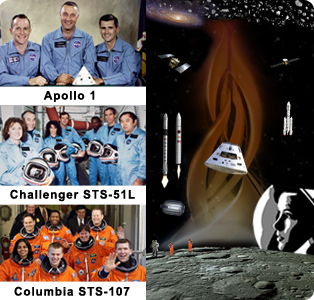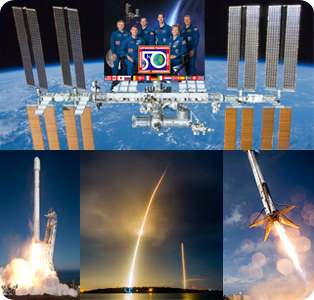Commemorating Space Explorers with an Eye Toward Future Horizons
|
MONDAY Ongoing…
|

![]() = All times
= All times
for terrestrial events in local time unless noted.
![]() = All times for international terrestrial events in local time unless noted.
= All times for international terrestrial events in local time unless noted.
![]() = All times for space events, and…
= All times for space events, and…
![]() = All times for international space / astro events in Hawaii Standard Time unless noted. Add 10 hours to obtain UT (‘Universal Time;’ Greenwich, England).
= All times for international space / astro events in Hawaii Standard Time unless noted. Add 10 hours to obtain UT (‘Universal Time;’ Greenwich, England).
Weekly Planet Watch – Evening Planets: Venus (SW), Mars (SW), Jupiter (S), Uranus (SW), Neptune (WSW); Morning Planets: Mercury (SE), Saturn (SE).
ISS in 2017: Advancing Humans in Space with Dragon CRS10, EVAs and Other Activities
A Falcon 9 two-stage rocket with cluster of 9 Merlin Engines generating 7,607 kN thrust at sea level is scheduled to launch Feb 8 carrying Dragon CRS-10 to the International Space Station. The US$61.2M list price per launch Falcon 9 rocket is claimed as the 1st space launch system completely developed in the 21st Century. It will also deploy the SAGE III Stratospheric Aerosol and Gas Experiment mission for NASA, a key part of the effort to provide crucial, long-term measurements to help humans understand and care for Earth’s atmosphere. ISS has 4 crewed missions and up to another 13 uncrewed robotic arrivals on the manifest for 2017. Soyuz MS-04 is scheduled March 11 with Expedition 51 Fyodor Yurchikhin, Jack Fischer; MS 05 May 29 Exp. 52 Sergey Ryazansky, Randy Bresnik, Paolo Nespoli; MS-06 Sep 12 Exp. 53 Mark Vande Hei, Alexander Misurkin; and MS-07 Nov 30 Exp 54 Scott Tingle, Alexander Skvortsov, Norishige Kanai. SpaceX Crew Dragon is set to arrive August on a demonstration mission. Early 2017 should see EVAs 40 & 41 in March, as well as QB-50, TechEdSat-5, Lemur-2 CubeSat Deployment. ISS could serve as a launch pad for the ‘Cislunar Super highway’ accelerating human exploration of Solar System Complete in the 21st Century. (Image Credit: SpaceX, NASA) |
Continued from…
TUESDAY
|
![]() Jan 24 — Rob and Terry Ryan Foundation, W. M. Keck Observatory, Kamuela HI: Cosmic Events: Focusing the Distant Universe with Gravitational Lensing; at Gates Performing Arts Center, HPA Campus.
Jan 24 — Rob and Terry Ryan Foundation, W. M. Keck Observatory, Kamuela HI: Cosmic Events: Focusing the Distant Universe with Gravitational Lensing; at Gates Performing Arts Center, HPA Campus.
![]() Jan 24 — Moon: 3.6° N of Saturn, 00:37.
Jan 24 — Moon: 3.6° N of Saturn, 00:37.
![]() Jan 24 — Apollo Asteroid 2011 CO14: Near-Earth Flyby (0.059 AU).
Jan 24 — Apollo Asteroid 2011 CO14: Near-Earth Flyby (0.059 AU).
WEDNESDAY
![]() Jan 25 — Opportunity, Mars Surface: Rover enters 14th year on Mars; holds “off-world” record for having driven the greatest distance; launched 2003, landed 2004.
Jan 25 — Opportunity, Mars Surface: Rover enters 14th year on Mars; holds “off-world” record for having driven the greatest distance; launched 2003, landed 2004.
![]() Jan 25 — Foothill College, Los Altos Hills CA: The Monster Black Hole at the Center of the Milky Way; Andrea Ghez, Professor of Astronomy at UCLA giving a free, illustrated, non-technical talk, 19:00.
Jan 25 — Foothill College, Los Altos Hills CA: The Monster Black Hole at the Center of the Milky Way; Andrea Ghez, Professor of Astronomy at UCLA giving a free, illustrated, non-technical talk, 19:00.
![]() Jan 25 — British Interplanetary Society, London, United Kingdom: Lecture: Future Histories and Forecasting; Stephen Baxter and Mark Hempsell.
Jan 25 — British Interplanetary Society, London, United Kingdom: Lecture: Future Histories and Forecasting; Stephen Baxter and Mark Hempsell.
![]() Jan 25 — Goddard Space Flight Center, NASA, Greenbelt MD: Colloquium: The Romance of Physics; Joseph Sucher Professor Emeritus of Physics at University of Maryland, 15:30.
Jan 25 — Goddard Space Flight Center, NASA, Greenbelt MD: Colloquium: The Romance of Physics; Joseph Sucher Professor Emeritus of Physics at University of Maryland, 15:30.
![]() Jan 25 — Moon: 3.7° N Mercury, 14:46.
Jan 25 — Moon: 3.7° N Mercury, 14:46.
![]() Jan 25 — Apollo Asteroid 7341 (1991 VK): Near-Earth Flyby (0.065 AU).
Jan 25 — Apollo Asteroid 7341 (1991 VK): Near-Earth Flyby (0.065 AU).
THURSDAY
![]() Jan 26 — Kennedy Space Center Visitor Center, NASA, Cape Canaveral FL: Annual NASA Day of Remembrance; at Astronauts Memorial Foundation hall.
Jan 26 — Kennedy Space Center Visitor Center, NASA, Cape Canaveral FL: Annual NASA Day of Remembrance; at Astronauts Memorial Foundation hall.
![]() Jan 26 — Cornell University, Ithaca NY: Lecture: The Life-Cycle of Gas in Dying Galaxies; Katherine Alatalo, Hubble Fellow from Carnegie Observatories, 16:00.
Jan 26 — Cornell University, Ithaca NY: Lecture: The Life-Cycle of Gas in Dying Galaxies; Katherine Alatalo, Hubble Fellow from Carnegie Observatories, 16:00.
![]() Jan 26-27 — National Science Foundation, Arlington VA: Astronomy and Astrophysics Advisory Committee (AAAC) Meeting.
Jan 26-27 — National Science Foundation, Arlington VA: Astronomy and Astrophysics Advisory Committee (AAAC) Meeting.
![]() Jan 26 — Apollo Asteroid 2017 AK3: Near-Earth Flyby (0.029 AU).
Jan 26 — Apollo Asteroid 2017 AK3: Near-Earth Flyby (0.029 AU).
![]() Jan 26 — Apollo Asteroid 2016 YP4: Near-Earth Flyby (0.033 AU).
Jan 26 — Apollo Asteroid 2016 YP4: Near-Earth Flyby (0.033 AU).
FRIDAY
![]() Jan 27 — ISS, HTV-6 Departure, LEO: JAXA H-II Transfer Vehicle (HTV-6) release from International Space Station scheduled at 10:30 ET, live coverage available.
Jan 27 — ISS, HTV-6 Departure, LEO: JAXA H-II Transfer Vehicle (HTV-6) release from International Space Station scheduled at 10:30 ET, live coverage available.
![]() Jan 27 — Apollo 1 50th Observation, Nationwide USA: Increasing space awareness and education, remembrances and events honor three Apollo 1 crew members lost during a launch pad test: Command Pilot Virgil “Gus” Grissom, Senior Pilot Edward H. White and Pilot Roger B. Chaffee.
Jan 27 — Apollo 1 50th Observation, Nationwide USA: Increasing space awareness and education, remembrances and events honor three Apollo 1 crew members lost during a launch pad test: Command Pilot Virgil “Gus” Grissom, Senior Pilot Edward H. White and Pilot Roger B. Chaffee.
![]() Jan 27 — United Nations Outer Space Treaty (OST) 50th Observation, Worldwide: OST framework to address legal questions for capabilities and activities in Space open for signature by United Nations General Assembly on this day in 1967, and entered into force October 10, 1967; evolving / unfolding regulations include commercial space activities, private space stations, habitats on Moon, asteroid mining, contamination of celestial bodies.
Jan 27 — United Nations Outer Space Treaty (OST) 50th Observation, Worldwide: OST framework to address legal questions for capabilities and activities in Space open for signature by United Nations General Assembly on this day in 1967, and entered into force October 10, 1967; evolving / unfolding regulations include commercial space activities, private space stations, habitats on Moon, asteroid mining, contamination of celestial bodies.
![]() Jan 27 — Moon: New Moon, 14:07.
Jan 27 — Moon: New Moon, 14:07.
SATURDAY
![]() Jan 28 — Arianespace, Launch Soyuz / Hispasat AG1, Sinnamary, French Guiana: Arianespace Soyuz, designated VS16, to launch Hispasat AG1 communications satellite (also known as Hispasat 36W-1) to provide communications services over Spain, Portugal and the Americas.
Jan 28 — Arianespace, Launch Soyuz / Hispasat AG1, Sinnamary, French Guiana: Arianespace Soyuz, designated VS16, to launch Hispasat AG1 communications satellite (also known as Hispasat 36W-1) to provide communications services over Spain, Portugal and the Americas.
![]() Jan 28 — Challenger STS-51L 31st Observation, Nationwide USA: Educational and ceremonial events held worldwide to advance space technology / education and honor 7 crew members killed in shuttle accident 28 January 1986: Commander Francis R. “Dick” Scobee, Pilot Michael J. Smith, Astronaut Christa McAuliffe (the 1st ‘Teacher in Space’), Mission Specialists Ellison S. Onizuka, Judith A. Resnick and Ronald E. McNair, along with Payload Specialist Gregory B. Jarvis.
Jan 28 — Challenger STS-51L 31st Observation, Nationwide USA: Educational and ceremonial events held worldwide to advance space technology / education and honor 7 crew members killed in shuttle accident 28 January 1986: Commander Francis R. “Dick” Scobee, Pilot Michael J. Smith, Astronaut Christa McAuliffe (the 1st ‘Teacher in Space’), Mission Specialists Ellison S. Onizuka, Judith A. Resnick and Ronald E. McNair, along with Payload Specialist Gregory B. Jarvis.
![]() Jan 28 — Jet Propulsion Laboratory, NASA/Caltech, Pasadena CA: National Science Bowl – Los Angeles Regional Competition; high school students teams challenges with questions about chemistry, biology, physics mathematics, astronomy, Earth and computer science.
Jan 28 — Jet Propulsion Laboratory, NASA/Caltech, Pasadena CA: National Science Bowl – Los Angeles Regional Competition; high school students teams challenges with questions about chemistry, biology, physics mathematics, astronomy, Earth and computer science.
![]() Jan 28 — China Lunar New Year, Zhong Guo / Worldwide: China Lunar New Year 2017 Spring Festival marks the Year of the Rooster.
Jan 28 — China Lunar New Year, Zhong Guo / Worldwide: China Lunar New Year 2017 Spring Festival marks the Year of the Rooster.
SUNDAY
![]() Jan 29 – Feb 3 — American Geophysical Union, Hobart, Tasmania, Australia: AGU Chapman Conference on Submarine Volcanism: New Approaches and Research Frontiers.
Jan 29 – Feb 3 — American Geophysical Union, Hobart, Tasmania, Australia: AGU Chapman Conference on Submarine Volcanism: New Approaches and Research Frontiers.

